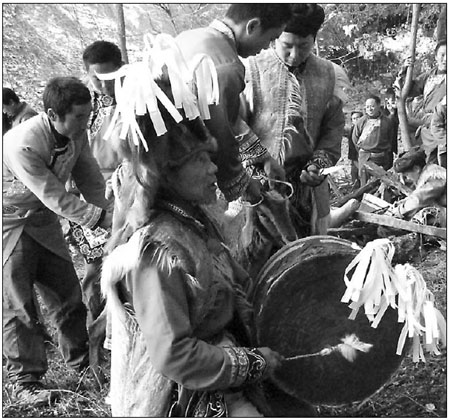One for posterity
|
A Shibi, or sorcerer, at A'er village, hosts a ceremony to worship the Qiang ethnic group's god. Photos Provided to China Daily |
|
Zhu Jinlong, a Shibi at A'er village, makes cakes resembling the sun and the moon for a religious ceremony. |
An NGO is helping China's ethnic groups keep a record of their age-old customs and rituals. Shi Xi reports.
Driving into A'er village in Sichuan province, Chinese Academy of Social Sciences researcher Luo Jihua had a strange feeling. The ancient village has been home to the Qiang ethnic group for nearly 1,000 years.
"Although I am a Qiang, I know so little about my own community," Luo says.
Born and raised in the Beichuan Qiang autonomous county, Luo had always known she was a Qiang but had no idea what set aside her ethnic group, as she went to the same schools and lived the same life as most of her Han friends.
"The school taught me everything except who I was," Luo says.
The 2008 Wenchuan earthquake that drew public attention to the preservation of Qiang culture suddenly made Luo aware of her own identity.
When she saw the A'er Village Qiang Ethnic Cultural Revitalization program on the website of Beijing Cultural Protection Center, an NGO, in 2009, she volunteered to join it in a heartbeat.
"I wanted to find my roots," Luo says, "and to do something for my people."
The program was aimed at raising awareness of Qiang culture and helping the group keep a record of its rituals and customs.
At first, Luo and her team found it difficult to win the trust of the Qiang. When the earthquake struck, and word got around that many Qiang cultural relics had been destroyed, scholars and folklore experts swarmed to the remote village to record whatever had survived to complete their research projects. They left without a trace.
"We were like tools to them and they did not even bother to check the accuracy of what they recorded with us," says Yu Shihua, a Shibi, someone who holds a special position in the Qiang religion. "Some of it was obviously wrong."
Luo and her teammates had a hard time bridging the trust gap. They showed the villagers the Mengma Archive, the result of another of the protection center's cultural revitalization projects in Mengma Village in Yunnan. They explained every detail and procedure, and taught the villagers how to use the cameras to record their rituals. They also signed a contract with the locals guaranteeing their full rights to the final product.
Gradually more villagers began to participate in the project.
"We put our heads together, tracing back every ritual we could think of. We wanted to make it as detailed and accurate as possible," Yu says.
The Qiang New Year is the most important festival for this ethnic group. It symbolizes fortune and happiness and is an occasion to give thanks to the gods.
Given the reconstruction work after the earthquake and the winter storm, Luo did not expect the locals to hold their traditional ceremony.
But to her surprise, 68 families in the village donated 50 yuan ($7.60) each to observe all the traditional customs associated with the New Year - for the first time in dozens of years.
"We want it to be recorded and passed down, for it is our way to show gratitude to the god of heaven, the god of the mountain and the god of the village," Yu says.
"Seeing the young and the old in Qiang clothing and accessories dancing and singing around the bonfire, I couldn't help but join them," Luo says.
What touched her most were the animated debates over the written documents.
While elderly Qiang wanted only the age-old rituals to be recorded, the younger generation argued that changes that have crept in over the years should also be included.
"Sometimes they would discuss the draft in Yu's home from 6 pm to 2 am," Luo says. "I liked to see them argue as that gave them a better understanding of their own culture. And that, ultimately, is the goal of our project."
"Going through the history of the Qiang people with the locals felt like a self-discovery," Luo says. "But I still have a long way to go."
By the end of 2010, the 14 volunteers had helped prepare a written document of more than 70,000 words and a 1,700-word book of everyday Qiang expressions.
The A'er Village Qiang Ethnic Cultural Revitalization Project is Beijing Cultural Protection Center's third attempt to raise awareness of the need to protect their unique culture among the nation's ethnic groups.
Their first project in 2004 helped the Dai people of Mengma town record all aspects of their culture in their own script.
In 2009, UNESCO used the same approach for the "Congjiang Archive Project", done jointly with the center, about the Dong ethnic people in Guizhou province.
























